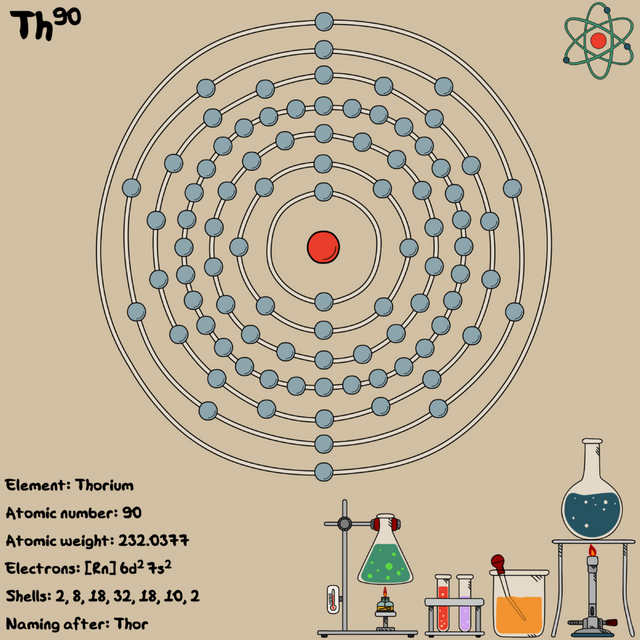Thorium for cleaner and safer nuclear energy
Thorium is a radioactive element that exists in nature in a single isotopic form: thorium 232. It decays very slowly: its half-life is equal to 14.5 billion years, about three times the age of the earth. Thorium research was born to investigate its potential use as a fuel in nuclear reactors.
Currently, the fuel traditionally used in reactors is uranium 235. Thorium and uranium, despite having similar properties, differ in their behavior. Uranium 235 is a fissile material: when hit by a neutron, it gives rise to a fission reaction, releasing other neutrons that trigger new fission reactions. On the contrary, thorium is a fertile material: when it absorbs a neutron it decays until it transforms into a fissile element, uranium 233. For this reason, thorium can be used in breeder reactors, ie those reactors in which the fuel is composed both from uranium 235 (fissile) and from thorium 232 (fertile). In this way, it is possible to have a continuous availability of fissile: as it is consumed, uranium 235 is replaced by uranium 233, produced by the transformation of thorium. Research on thorium is conducted in parallel with that on safer and more innovative fourth generation reactors, which envisage its use as a component of nuclear fuel. The fourth generation reactors are, like their antecedents, reactors that produce energy by means of fission reactions but which are distinguished from the former because they represent an evolution in terms of safety and sustainability. Compared to uranium, the use of thorium has several advantages:

It is more abundant: in the earth's crust it is present in quantities of about four times higher. This means that it can respond to the growing demand for energy over the long term.
A thorium-powered reactor produces fewer long-lived radioactive elements such as plutonium, americium and curium. This means that the spent fuel that remains in the reactor has a dangerousness of several orders of magnitude lower than that of a uranium reactor and that the waste produced can be disposed of more easily. The main source of radiotoxicity (i.e. the ability to produce harmful effects for the organism) is in fact represented by plutonium and long-lived radioactive elements that are generated during the reactor's operation and that remain in the nuclear fuel once the uranium it is consumed. Plutonium is generated mainly from uranium 238, an isotope widely present in traditional uranium-based fuel. If this is replaced by thorium, the production of plutonium is significantly reduced and with it the radiotoxicity of the spent fuel.
This aspect also allows to reduce another risk: the theft of spent nuclear fuel for war purposes, or to build a weapon. A nuclear device requires a certain amount of particularly "pure" plutonium, which the thorium cycle does not produce. A further barrier against nuclear proliferation is offered by the radiation field associated with the spent fuel from thorium: uranium 233 produced by thorium can decay into uranium 232, an isotope that emits very dangerous gamma radiation. It thus becomes much more difficult to handle the material to make a bomb.
Thorium, like uranium, is used in the form of oxide to produce fuel. Thorium oxide has a much higher thermal conductivity than uranium oxide. The resulting higher thermal stability allows the fuel temperature to be reduced, consequently reducing the release into the reactor of gaseous fission products (which tend to “poison” the fuel, preventing its complete fission). Limiting the release of these gaseous products means being able to exploit the fuel more effectively, consuming a greater quantity. In this regard, it is estimated that 90% of uranium 233 produced from thorium undergoes the fission reaction while only the remaining 10% remains in the spent fuel: this means that 90% of the fissile material is usable. The main positive consequence is that the plant will stop less frequently for refueling.
Uranium 233 produced from fertile thorium is a better fuel than uranium 235 and plutonium 239 at high temperatures. This makes it more suitable for use in the high temperature reactor chain.
-In addition to new generation reactors, thorium-based fuel could be used in traditional reactors that run on uranium, with minor technical changes to the reactor configuration. For example, it could be used in the Canadian chain of CANDU reactors, which need a lower concentration of fissile in order to function.
The main disadvantage is that thorium cannot be used alone as a fuel: an initial amount of fissile material, such as uranium 235, must be added in order to provide the neutrons necessary to fertilize thorium. Furthermore, it is more difficult to reprocess the thorium-based fuel, i.e. to remove the residual fissile material in order to be able to use it again in the reactor. The research continues on this issue, aiming to solve the challenges still present and exploiting the advantages that this resource offers in order to make nuclear power a cleaner and safer source of energy.
You've got a free upvote from witness fuli.
Peace & Love!